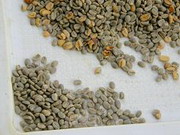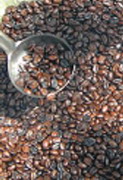|
Green beans:- The top quality coffee (No 1) check that it is not called "A" grade!! ("A" grade is NOT an "official" designation of Jamaican coffee) and in all but the smallest quantities, will be packed and shipped in wooden barrels, only the lower grades come in quantity, in "bags", or sacks. No 2 and No 3 grades, physically identical in all respects to No 1 grade, except in the sorting screen size. It is somewhat difficult to get a precise definition of the Coffee Boards' policy, of only exporting "Top Grade" coffee to the USA: do they mean only No 1 grade, or do they include, Nos. 2 and 3 grades?? out of the 9 designated, separate grades of coffee. No 1 grade beans should all be of 17 and 18 screen size (bean size is measured in 64ths of an inch, so a 17 screen size is 17/64ths of an inch: second grade coffee (No 2) is sorted at 16/64ths (= 1/4 inch) and No 3, is sorted with a 15/64ths screen. Pea beans are graded at 10 (= 5/32nds of an inch). Only coffee that achieves these sorting standards, can be exported as green beans. All the lower grades, can only be exported as roasted whole beans, or roasted and ground, or as a coffee "by product" (coffee liqueurs, or that instant muck!!). BUT, even these lower grades, still have to meet the required quality standards, of the CIB, if they fail the quality criteria, they cannot be exported, in any form, and can only be sold, locally, in Jamaica. To check your green beans:- The first thing is to check the packaging, (look for the CIB stamps, logo, and the registered trade marks) and batch numbers. Open the container/pack, and grab a good double handful of the beans, and stick your nose in them!! Smell is an excellent way of detecting if the beans are "fresh", and for any fungal presence. The "nose" is such a personal thing, that it is very difficult to describe the odours coming off the coffee: the presence of any fungal infection, is fairly obvious; but the "fresh or stale" smell is much more difficult to describe. Old, poor, badly stored, or stale, coffee; lacks the "vibrant, living" odour, that comes with fresh beans; and can, if poorly stored, pick up the smell of anything around it (especially hydrocarbons (petrol, diesel oil, etc) and the "scents" as added to cleaning products, clothes washing detergents, being particularly noticeable). The colour is described as jade, or blue/green to green: to my colour vision, I would describe the colour as a bluish, slate grey; but the most important thing is that they are all (or very close to) the same colour, no obviously "patchy" or obviously lighter or darker, coloured beans. Neither of my digital cameras will give the colour, correctly; but the picture below is fairly close, and should be ok as a guide. (ignore the few parchment (yellowish) beans in the picture)
Green beans, being graded. If I miss a couple of "duff" beans, the first time, get them during the second, grading. Every bean should be perfect, no marks, holes, black spots (usually insect damage) or mottled (if with various colours: is usually a sign of fungal attack: if mottled with lighter patches, can indicate poor drying techniques) and with minimal (but some) silver skin left on some of them. To remove the silver skin completely, requires that the coffee is "polished", and unless great care is taken, the friction raises the temperature of the beans, to a point where the flavour is impaired. A little silver skin, is perfectly acceptable, if not, almost, an advantage! The CIB specification allows a 3% defect rate (minor defects only; when you read, in a later episode, how the beans are graded, you will understand the impossibility of removing every single defective bean!!) and a 4% allowance on slightly smaller beans; this allowance is due to the mechanical tolerances of the sorting machines. Whole Roast Beans:-
Fresh roasted beans, still warm! Roasted in our Dutch pot, over the wood fire: this level of colour variations should NOT be visible in a professionally roasted coffee. The smell is the first, and most important test, a rich, tingling, exciting odour, if you get an odour of (smells to me like:-) stale or rancid, chocolate or drinking chocolate, it is "old", poorly stored, or just plain rubbish. Freshly roasted beans will have a very strong smell of "coffee", with several other secondary odours; one of the strongest of which, is very similar to Ganga (which I am sure a few of you have "experienced"!!), all the odours from the coffee should be exciting, and vibrant, with nothing remotely "unpleasant" in the overall smell. As a general rule, the weaker, and less "exciting" the smell, the lower the quality, or the older the coffee, since roasting: any noticeable "unpleasant" odours, and you have got some "bad" coffee. Over roasting and the coffee has a distinct "burnt" smell, and will probably give a bitter, acidic, brew. Our coffee is at its best, after about a 3 day "resting", period, following the roasting and cooling. In a sealed packet (preferable vacuum packed), it is fine for months: after opening, if kept in a sealed container, in the refrigerator, should be ok for several more weeks. Always check the batch number and the dates on the packets, to ensure that it is not too old. If stored properly, green beans don't deteriorate for up to 15 months. After roasting, the flavour starts to "fade": it is absolutely pointless "saving" any good quality roasted, coffee; drink it within a few weeks of opening the pack: and ideally, within a couple of months, after roasting. The beans expand slightly during roasting, so not a single roasted bean should go through the same screen size, as the green bean sorting. Easiest way to test this, ( for # 1 and # 2 grade beans ) is to make your own "sorting checker": any undersized beans, will fall through, if you get more than the odd 1 or 2 roasted beans from 4 ounces of coffee, it is NOT a properly sorted coffee. You may also get a few black "flakes" in the coffee, this is usually the roasted-off remains of the silver skin on the beans: which should not be present in "excessive" amounts, a little is to be expected. NOTE: to make your own "sorting checker": get a large, (at least, 6 to 8 inch diameter) flat based, plastic bottle, cut off the top, (leaving the base a couple of inches deep) and place it on a large piece of soft wood: add a very small amount of water, to keep the drill, and the plastic, cool: drill a load of 1/4 inch (= 16 grade, for green beans) holes in the base: great care must be taken to ensure that the drill makes a clean, perfect hole, and the drilling should be from the "inside", to keep the holes as "clean" as possible: it is all too easy to get some of the holes, too big! Robin Plough, friend of www.coffee4dummies.com For questions about JBM, mail to: Этот e-mail адрес защищен от спам-ботов, для его просмотра у Вас должен быть включен Javascript |
Assessing your coffee (part 2)
Assessing your coffee (part 2)







